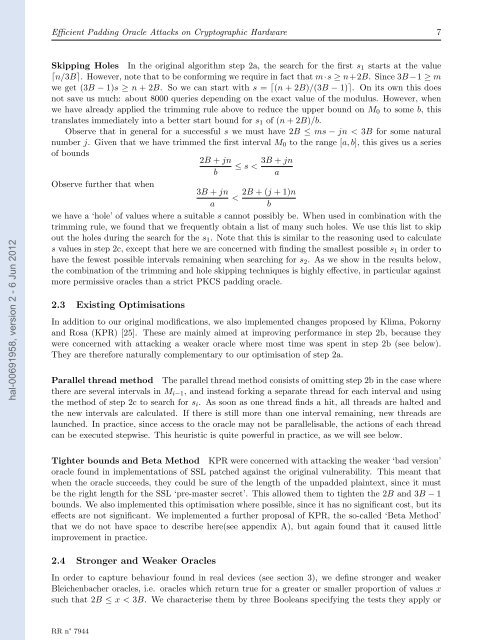RR-7944
RR-7944
RR-7944
Create successful ePaper yourself
Turn your PDF publications into a flip-book with our unique Google optimized e-Paper software.
hal-00691958, version 2 - 6 Jun 2012<br />
Efficient Padding Oracle Attacks on Cryptographic Hardware 7<br />
Skipping Holes In the original algorithm step 2a, the search for the first s1 starts at the value<br />
⌈n/3B⌉. However, note that to be conforming we require in fact that m·s ≥ n+2B. Since 3B −1 ≥ m<br />
we get (3B − 1)s ≥ n + 2B. So we can start with s = ⌈(n + 2B)/(3B − 1)⌉. On its own this does<br />
not save us much: about 8000 queries depending on the exact value of the modulus. However, when<br />
we have already applied the trimming rule above to reduce the upper bound on M0 to some b, this<br />
translates immediately into a better start bound for s1 of (n + 2B)/b.<br />
Observe that in general for a successful s we must have 2B ≤ ms − jn < 3B for some natural<br />
number j. Given that we have trimmed the first interval M0 to the range [a, b], this gives us a series<br />
of bounds<br />
2B + jn<br />
b<br />
≤ s <<br />
3B + jn<br />
a<br />
Observe further that when<br />
3B + jn<br />
<<br />
a<br />
2B + (j + 1)n<br />
b<br />
we have a ‘hole’ of values where a suitable s cannot possibly be. When used in combination with the<br />
trimming rule, we found that we frequently obtain a list of many such holes. We use this list to skip<br />
out the holes during the search for the s1. Note that this is similar to the reasoning used to calculate<br />
s values in step 2c, except that here we are concerned with finding the smallest possible s1 in order to<br />
have the fewest possible intervals remaining when searching for s2. As we show in the results below,<br />
the combination of the trimming and hole skipping techniques is highly effective, in particular against<br />
more permissive oracles than a strict PKCS padding oracle.<br />
2.3 Existing Optimisations<br />
In addition to our original modifications, we also implemented changes proposed by Klima, Pokorny<br />
and Rosa (KPR) [25]. These are mainly aimed at improving performance in step 2b, because they<br />
were concerned with attacking a weaker oracle where most time was spent in step 2b (see below).<br />
They are therefore naturally complementary to our optimisation of step 2a.<br />
Parallel thread method The parallel thread method consists of omitting step 2b in the case where<br />
there are several intervals in Mi−1, and instead forking a separate thread for each interval and using<br />
the method of step 2c to search for si. As soon as one thread finds a hit, all threads are halted and<br />
the new intervals are calculated. If there is still more than one interval remaining, new threads are<br />
launched. In practice, since access to the oracle may not be parallelisable, the actions of each thread<br />
can be executed stepwise. This heuristic is quite powerful in practice, as we will see below.<br />
Tighter bounds and Beta Method KPR were concerned with attacking the weaker ‘bad version’<br />
oracle found in implementations of SSL patched against the original vulnerability. This meant that<br />
when the oracle succeeds, they could be sure of the length of the unpadded plaintext, since it must<br />
be the right length for the SSL ‘pre-master secret’. This allowed them to tighten the 2B and 3B − 1<br />
bounds. We also implemented this optimisation where possible, since it has no significant cost, but its<br />
effects are not significant. We implemented a further proposal of KPR, the so-called ‘Beta Method’<br />
that we do not have space to describe here(see appendix A), but again found that it caused little<br />
improvement in practice.<br />
2.4 Stronger and Weaker Oracles<br />
In order to capture behaviour found in real devices (see section 3), we define stronger and weaker<br />
Bleichenbacher oracles, i.e. oracles which return true for a greater or smaller proportion of values x<br />
such that 2B ≤ x < 3B. We characterise them by three Booleans specifying the tests they apply or<br />
<strong>RR</strong> n° <strong>7944</strong>


